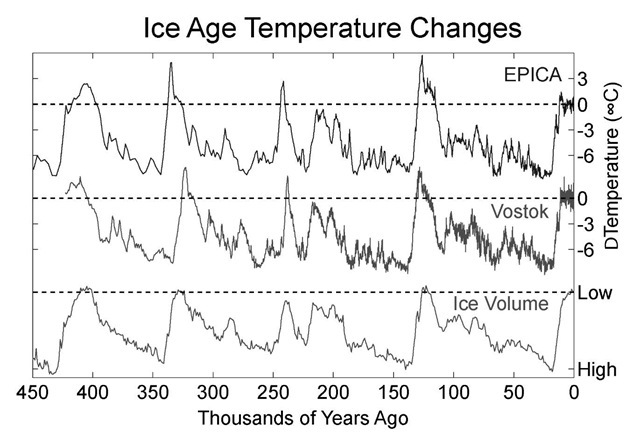This figure shows the Antarctic temperature changes during the last several glacial/interglacial cycles of the present ice age and a comparison to changes in global ice volume. The present day is on the right.
The first two curves show local changes in temperature at two sites in Antarctica as derived from deuterium isotopic measurements (5D) on ice cores (EPICA Community Members 2004, Petit et al. 1999). The final plot shows a reconstruction of global ice volume based on 518O measurements on benthic foraminifera from a composite of globally distributed sediment cores and is scaled to match the scale of fluctuations in Antarctic temperature (Lisiecki and Raymo 2005). Note that changes in global ice volume and changes in Antarctic temperature are highly correlated, so one is a good estimate of the other, but differences in the sediment record do not necessarily reflect differences in paleotemperature. Horizontal lines indicate modern temperatures and ice volume. Differences in the alignment of various features reflect dating uncertainty and do not indicate different timing at different sites.
The Antarctic temperature records indicate that the present interglacial is relatively cool compared to previous interglacials, at least at these sites. It is believed that the interglacials themselves are triggered by changes in Earth’s orbit known as Milankovitch cycles and that the variations in individual interglacials can be partially explained by differences within this process. For example, Overpeck et al. (2006) argues that the previous interglacial was warmer because of increased solar radiation at high latitudes. The Liesecki and Raymo (2005) sediment reconstruction does not indicate significant differences between modern ice volume and previous interglacials, though some other studies do report slightly lower ice volumes/higher sea levels during the 120 ka and 400 ka interglacials (Karner et al. 2001, Hearty and Kaufman 2000). It should be noted that temperature changes at the typical equatorial site are believed to have been significantly less than the changes observed at high latitude.

